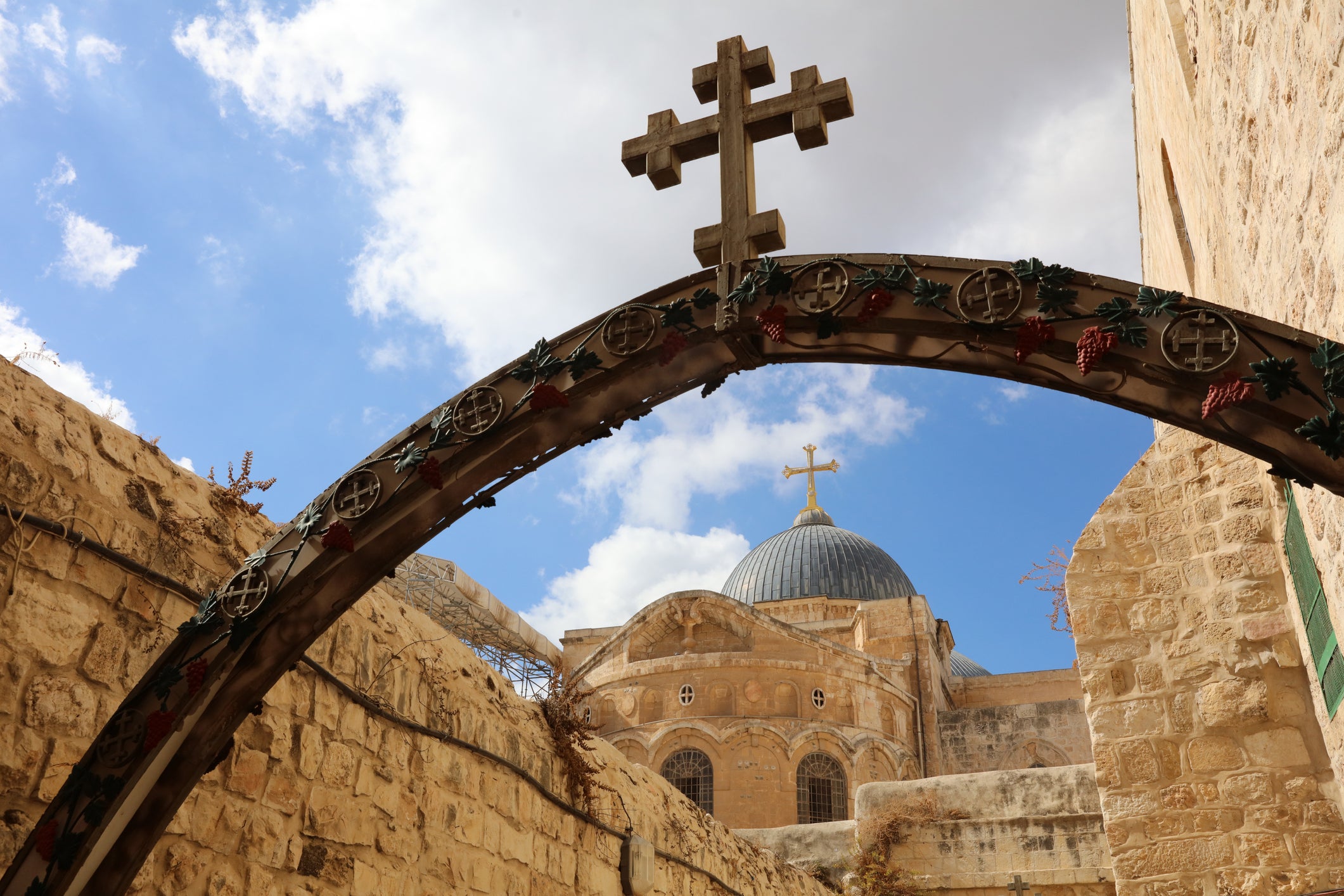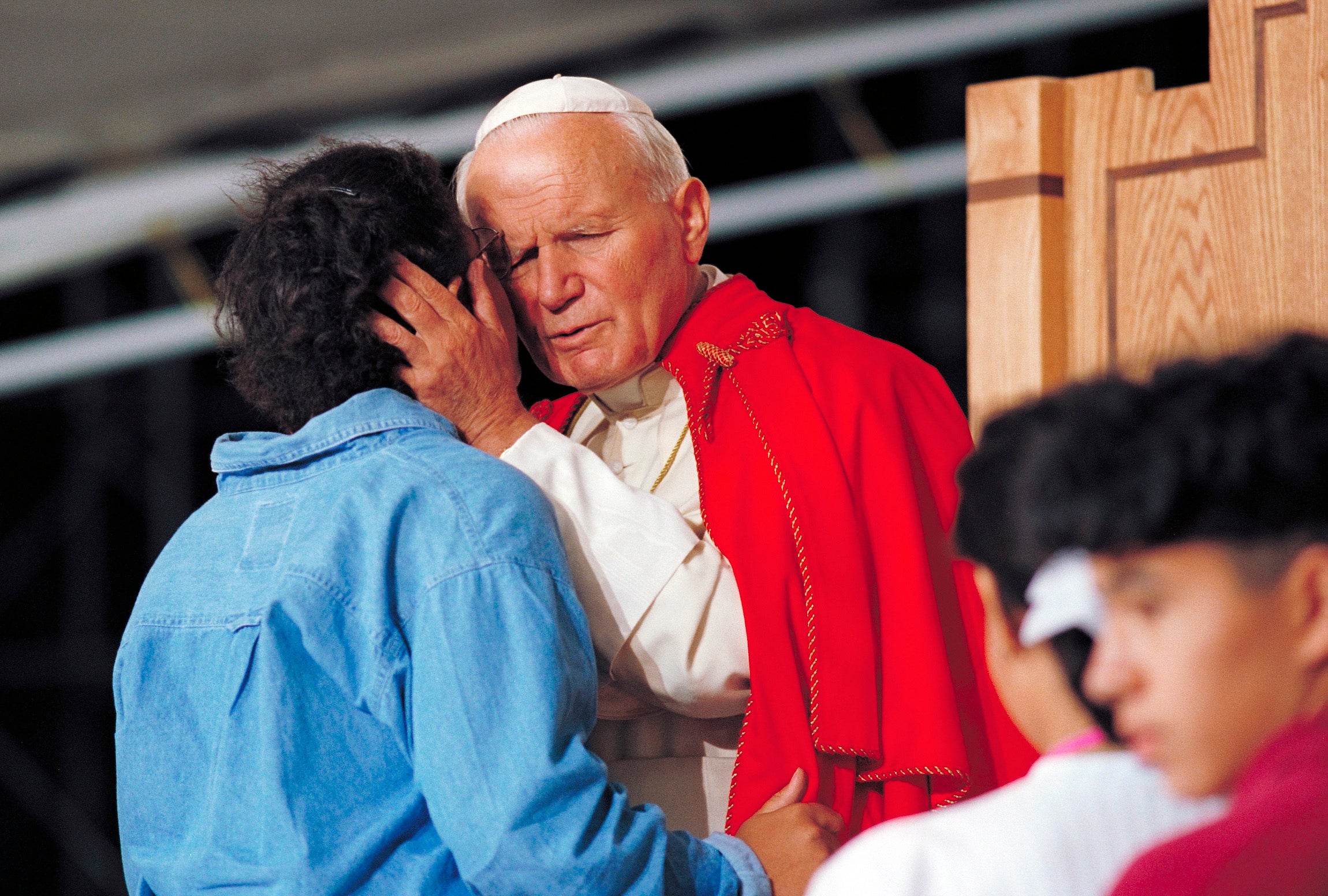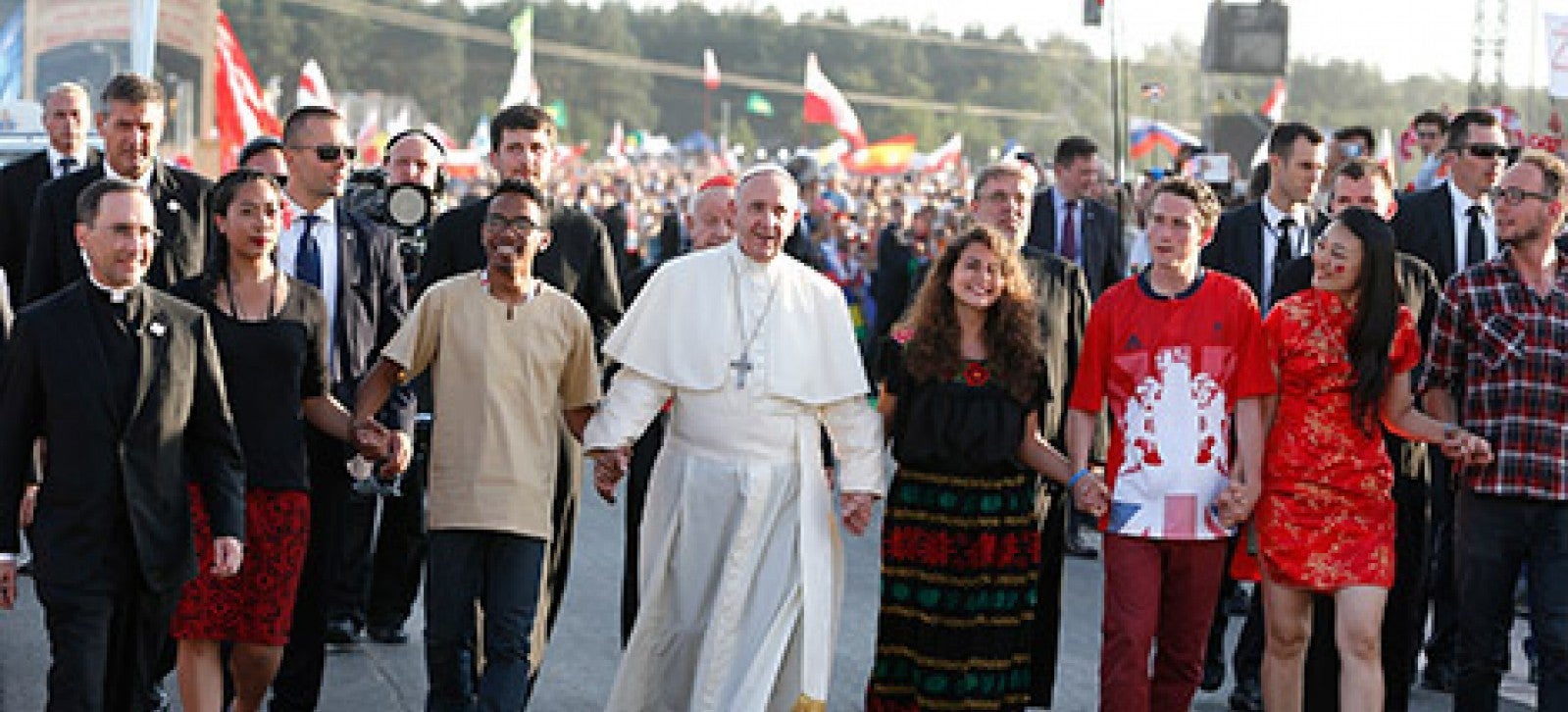Milestones and Foundations
Intentional and dynamic ministries with youth and young adults have been cornerstones of the Church's pastoral care and outreach since its very foundation.
"The Lord 'gave up his spirit' (cf. Mt 27:50) on a cross when he was little more than thirty years of age (cf. Lk 3:23). It is important to realize that Jesus was a young person. He gave his life when he was, in today's terms, a young adult." (Christus Vivit [CV] 23). Jesus' earthly ministry included, involved, and was centered on many young people and those who accompany them (see CV 12-29).
This page explores the historical background since then; in particular, the Church's engagement with young people.
Youth and young adults have been among the most prominent saints and holy women and men who have guided the Church through the ages. Some examples include the following individuals, showcased in CV 49-63:
- St. Sebastian (lived 200s AD)
- St. Francis of Assisi (d. 1226)
- St. Joan of Arc (b. 1412)
- Bl. Andrew Phu Yen (lived 1600s)
- St. Kateri Tekakwitha (lived 1600s)
- St. Dominic Savio (d. 1857)
- St. Therese of the Child Jesus (b. 1873)
- Bl. Ceferino Namuncura (d. 1905)
- Bl. Isidore Bakanja (d. 1909)
- Bl. Pier Giorgio Frassati (d. 1925)
- Bl. Marcel Callo (d. 1945)
- Bl. Chiara Badano (d. 1990)
- Bl. Carlo Acutis (d. 2006)
These and other saints have also been accompanied by wonderful teachers of the faith and pastoral ministers with a heart for young people including St. Philip Neri (d. 1595), St. John Bosco (d. 1888), St. Damien of Molokai (d. 1889), St. Michael McGivney (d. 1890), Ven. Augustus Tolton (d. 1897), Servant of God Jan Tyranowski (d. 1946), Servant of God Sr. Thea Bowman (d. 1990), St. Teresa of Calcutta (d. 1997), St. John Paul II (d. 2005), among countless others.
The Roman Catholic Church's ministries with youth and young adults in the United States have experienced key milestones throughout its history:
(Please note that in some documents, especially those in written before the 1990s and those from non-American contexts, the words "youth" or "young people" or "young persons" may refer to both adolescents and young adults in their 20s or 30s)
- 1792: Bishop John Carroll of Baltimore (first bishop from the United States) writes inaugural pastoral letter, saying, "I have considered the vitreous (sic) and Christian instruction of youth as a principle object of pastoral solitude."
- 1884: Cardinal James Gibbons of Baltimore writes pastoral letter saying every young person in the United States "shall have within his reach the means of education."
- 1930: Bishop Bernard J. Sheil, Auxiliary Bishop of Chicago, establishes the Catholic Youth Organization (CYO).
- 1933: National Catholic Welfare Conference (NCWC) [precursor to USCCB] releases statement, Family, Youth, and Business.
- 1934: Confraternity of Christian Doctrine (CCD) made an episcopal committee of the U.S. Bishops to support the faith formation of young people who could not attend a Catholic school.
- 1963: Second Vatican Council (Vatican II) convened
- 1963: Vatican II document on media, Inter Mifica, notes the presence of young people engaged in modern media (cf. IM 11)
- 1965: Vatican II document on bishops, Christus Dominus, notes pastors "should pay attention to adolescents and youth." (CD 30)
- 1965: Vatican II document on the laity, Apostolicam Actuositatem, notes that "adults ought to engage in friendly discussion with young people... and share the special benefits each generation can offer the other" (AA 12) and that "adolescents and young persons should be initiated into the (lay) apostolate and imbued with its spirit." (AA 30)
- 1965: Vatican II document on education, Gravissium Educationis, notes "the circumstances of our time have made it easier and at once more urgent to educate young people" (GE introduction)
- 1971: The Vatican releases the General Catechetical Directory on the formation of young people
- 1972: National Conference of Catholic Bishops (NCCB) [precursor to USCCB] releases statement, To Teach as Jesus Did, on the formation of young people, specifically noting the work of "ministry. to youth" (p. 131).
- 1972: The U.S. Church convenes a first national Encuentro for Hispanic/Latino ministry.
- 1972: National Conference of Catholic Bishops releases statement, The Diocesan Youth Director.
- 1976: United States Catholic Conference (USCC) [precursor to USCCB] releases document, A Vision of Youth Ministry, a landmark document establishing the overall framework for the U.S. Church's pastoral outreach to adolescents.
- 1977: The Archdiocese of Chicago establishes an Office for Young Adult Ministry aimed at pastoral outreach to those in their 20s and 30s (one of the first in the United States) under the leadership of Fr. John Cusick.
- 1977: The U.S. Church convenes a second national Encuentro for Hispanic/Latino ministry, with the pastoral care of Hispanic youth and young adults emerging as a top priority.
- 1978: The Southeast Pastoral Institute (SEPI), based in Miami, Florida, was established (along with other regional offices for the U.S. Bishops) to support the regional development of Hispanic/Latino ministry, with a particular focus on the young.
- 1980: SEPI creates first course in Pastoral Juvenil Hispana (and a subsequent Pascua Juvenil program in 1981)
- 1981: Theology-on-Tap (for young adults) first developed in the Archdiocese of Chicago.
- 1982: The National Federation for Catholic Youth Ministry (NFCYM) established to serve and connect ministry leaders who accompany adolescents in Catholic settings across the United States.
- 1982: The National Catholic Young Adult Ministry Association (NCYAMA) established to serve and connect ministry leaders who accompany young adults in their 20s and 30s in Catholic settings across the United States.
- 1983: NFCYM hosts first major regional youth conferences in San Francisco and Washington DC [precursor to NCYC]
- 1984: First international gathering of youth and young adults (precursor of World Youth Day) during the Jubilee Year of Redemption, convened on Palm Sunday in Rome by St. John Paul II.
- 1985: The U.S. Church convenes a third national Encuentro for Hispanic/Latino ministry.
- 1985: Formal establishment of World Youth Day (WYD) by St. John Paul II.
- 1986: The National African American Catholic Youth & Young Adult Ministry Network (NAACYYAMN) was founded by a group of youth ministers, diocesan youth staff, and directors of Black Catholic offices in response to the needs of African American youth ministers, youth, and young adults.
- 1986: NFCYM publishes its first document, The Challenge of Adolescent Catechesis.
- 1986: First annual WYD takes place in Rome, beginning annual tradition (to occur on Palm Sunday).
- 1987: The United States Catholic Conference releases the National Pastoral Plan for Hispanic Ministry, which identified youth and young adults as a preferential option. It further created a National Youth Task Force, which became the Comite Nacional Hispano de Pastoral Juvenil [the precursor to LaRED].
- 1991: NFCYM hosts first (nationwide) National Catholic Youth Conference (NCYC) in Indianapolis, Indiana.
- 1993: First WYD in North America takes place in Denver, Colorado, USA, drawing 500,000 participants.
- 1994: Instituto Fe Y Vida founded to respond to the needs of Hispanic/Latino young people.
- 1996: The NCCB releases Sons and Daughters of the Light: A Pastoral Plan for Ministry with Young Adults, a landmark document establishing the overall framework for the U.S. Church's pastoral outreach to young adults.
- 1997: The NCCB releases Renewing the Vision: A Framework for Catholic Youth Ministry, a landmark document re-establishing the overall framework for the U.S. Church's pastoral outreach to adolescents.
- 1997: The National Catholic Network de Pastoral Juvenil Hispana (LaRED) founded with support from NCCHM, SEPI, Instituto Fe Y Vida, and the USCCB Secretariat for Hispanic Affairs.
- 2000: The USCCB convenes a fourth national Encuentro for all cultural communities and races across the United States.
- 2001: Instituto Fe Y Vida launches the 10-year Hispanic Youth and Young Adult Ministry Initiative to promote a response to the urgent need to make Hispanic young people a priority for the Catholic Church.
- 2002: Second WYD in North America takes place in Toronto, Ontario, Canada, drawing 800,000 participants.
- 2004: LaRED, with support from the USCCB Committee on Hispanic Affairs, convokes the Primer Encuentro Nacional Hispano de Pastoral Juvenil (PJH) to listen to the voices of Hispanic/Latino young people and discern best ways to respond
- 2005: The Emerging Models of Pastoral Leadership Project is convened by a collaborative network of organizations, including NCYAMA, that looks at the next generation of Catholic leaders and parish life, that takes place from 2005 to 2008.
- 2006: The national gathering of the PJH Encuentro is held at the University of Notre Dame in South Bend, Indiana.
- 2008: The Emerging Models of Pastoral Leadership Summit is held in Orlando, Florida.
- 2008: LaRED, in partnership with USCCB, publishes Conclusiones from the 2004-2006 PJH Encuentro.
- 2010: The Emerging Models Project releases The Next Generation of Pastoral Leaders: What the Church Needs to Know, on the realities facing young adults serving as pastoral leaders in the Catholic Church.
- 2010: The USCCB releases Connecting Young Adults to Catholic Parishes, on applications of Sons and Daughters of the Light.
- 2014: The USCCB forms a National Team of Accompaniment to Prepare for the Fifth Encuentro (ENAHVE) to inaugurate a process that will lead up to the formal beginning of the Fifth National Encuentro [V Encuentro] on Hispanic/Latino ministry in 2017, with youth and young adults identified as a major priority area.
- 2016: The NCYAMA organization formally dissolves as a national coalition for ministry with young adults; the National Advisory Team on Young Adult Ministry (NATYAM), assisting the USCCB Committee on Laity, Marriage, Family Life and Youth, is established.
- 2016: World Youth Day in Krakow, Poland, takes place, where over 29,000 young people from across the United States take part, one of the largest delegations ever for a WYD outside North America.
- 2016: The Holy See inaugurates a worldwide synodal process focused on "young people, the faith, and vocational discernment" that takes place from 2016 to 2018.
- 2017: The USCCB holds a Convocation for Catholic Leaders in Orlando, Florida, with a special focus on emerging young leaders.
- 2017: The National Dialogue on Catholic Pastoral Ministry with Youth and Young Adults, a joint collaboration between NFCYM, CCMA, NATYAM, LaRED, and the USCCB, begins its multi-year process to renew Catholic ministry with youth and young adults.
- 2017: The USCCB convenes the V Encuentro for Hispanic/Latino ministry, with a particular focus on young people. This process takes place from 2017 to 2019.
- 2018: The Holy See holds the XV Ordinary Synod of Bishops on Young People, the Faith, and Vocational Discernment in Rome (October 2018), preceded by an unprecedented pre-synod gathering of young people (March 2018) from around the world.
- 2019: World Youth Day in Panama takes place. Approximately 12,000 pilgrims from the USA attend.
- 2019: Pope Francis releases his apostolic exhortation Christus Vivit (the first papal exhortation on young people).
- 2019: The USCCB releases its Proceedings and Conclusions from the V National Encuentro process, which integrates and highlights the significant amount of contributions from and about youth and young adults.
- 2020: The COVID-19 global pandemic strikes, impacting ministries with youth and young adults due to the significant effect of social distancing and isolation on young people's mental health, as well as the financial impact on the Church's investment in these ministries.
- 2020: Pope Francis announces a formal realignment of the annual global celebration of young people (the annual WYD commemorations) to now occur on Christ the King Sunday.
- 2020: LaRED formally announces a "Decade of Pastoral Juvenil" for 2020-2030, flowing from the V Encuentro process.
- 2020: Inspired by Christus Vivit, the USCCB launches the Journeying Together intercultural encounter process for the Church's ministries with youth and young adults, that continues through 2022. This process brings together young people, ministry leaders, and bishops from the Asian and Pacific Islander, Black and African American, European American, Hispanic/Latino, Native American and Alaska Native, and Migrants, Refugees, and Travelers' cultural communities.
- 2021: The National Dialogue releases its Final Report on key findings from its multi-year collaborative initiative to renew the U.S. Church's approach to ministries with youth and young adults, in light of Christus Vivit.
- 2021: The Vatican Dicastery for Laity, Family and Life releases Pastoral Guidelines for the Celebration of World Youth Day in the Particular Churches, providing a renewed spiritual foundation for the annual occasions; the USCCB Administrative Committee formally approves realigning its national celebration of youth and young adults to Christ the King Sunday.
- 2021: The USCCB affirms the development and drafting of a new National Pastoral Framework on Youth and Young Adults at their June 2021 Plenary Assembly.
- 2021: Over 1,400 young adults, ministry leaders, and bishops take part in intercultural and intergenerational dialogue sessions as part of the USCCB Journeying Together process.
- 2022: The USCCB convenes "Alive in Christ: Young, Diverse, Prophetic Voices Journeying Together," a national gathering of young adults, bishops, and pastoral leaders from across cultures and communities to culminate the multi-year synodal dialogue of Journeying Together in Chicago. More details can be found online here.
- 2023: World Youth Day in Lisbon, Portugal takes place. Over 19,000 young people from the United States attend the international gathering, while thousands more celebrate stateside.
- 2024: The USCCB approves Listen, Teach, Send: A National Pastoral Framework for Ministries with Youth and Young Adults as part of their June 2024 Plenary Assembly (with 188 voting in favor, 4 against, and 4 abstaining). Listen, Teach, Send (available here) is the first major document on young people by the U.S. Church in over twenty-five years.
- 2025: The USCCB releases the Implementation Guide for Listen, Teach, Send (available here) on concrete ways to apply the pastoral framework's guidance in local settings: parish, school, family, campus, diocese, or eparchy.
- 2025: The USCCB hosts a National U.S. Pilgrim Gathering at the Papal Basilica of Saint Paul Outside the Walls in Rome as part of the Jubilee of Young People during the 2025 Jubilee Holy Year of Hope.
The Church's ministries with youth and young adults are still unfolding and the story is still being written. There are also many other milestones that have occurred on the local level that have advanced the Church's work with young people. This list is incomplete, but it gives a sense of the developments and growth in these ministerial areas that have taken place in the United States for over two centuries.
What will the next milestone be? That remains to be seen. However, as Pope Francis notes, "when you arrive where we have not yet reached, have the patience to wait for us." (CV 299)



